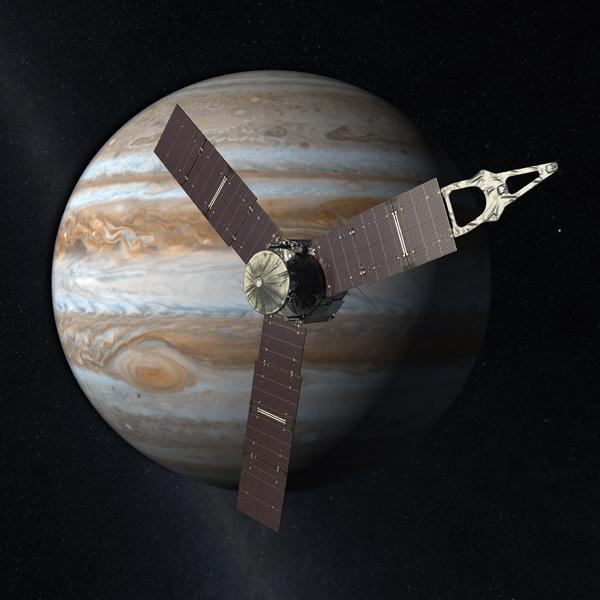Como ya adelantamos hace unos meses (ver http://andres96cmc.blogspot.com.es/2016/07/juno-llega-jupiter-juno-arrives-to.html), la sonda Juno enviada por la NASA llegó a la órbita de Júpiter. Ahora, la sonda ha obtenido su mayor acercamiento al planeta más grande del Sistema Solar, a unos 4200 kilómetros del planeta y a unos 2500 de sus primeras nubes. Es una sonda diseñada para estudiar Júpiter desde dentro de su atmósfera.
Este es el primero de 36 acercamientos que realizará la sonda para estudiar la composición, el núcleo y el campo magnético de Júpiter. La sonda se acercó unos 4200 km, como ya hemos dicho antes, a una velocidad superior a los 200000 km/h. El acercamiento culminó el pasado sábado a las 13:44 GMT, 14:44 hora española. En unos días todos los datos enviados por Juno sobre el planeta serán analizados por los expertos, obteniéndose las primeras conclusiones.
Juno fue lanzada en mayo del 2011, realizando una asistencia gravitatoria en la Tierra en septiembre de 2013 y finalmente llegando a la órbita planetaria en julio de este año. Se encargará de estudiar la composición de la atmósfera de Júpiter mediante aparatos de microondas e infrarrojos, su campo magnético, su campo gravitatorio para así establecer una distribución de la masa del planeta, sus emisiones de ondas electromagnéticas de distintas frecuencias... Es la sonda que más lejos ha llegado funcionando exclusivamente con energía solar, orbitando de polo a polo y no alrededor del Ecuador, como se ha hecho hasta ahora en los planetas exteriores. Tomará las imágenes con mayor resolución de Júpiter hasta ahora, terminando su misión en febrero de 2018.
As we talked about some months ago (see http://andres96cmc.blogspot.com.es/2016/07/juno-llega-jupiter-juno-arrives-to.html), the probe Juno of NASA arrived to the orbit of Jupiter. Now, the probe has made its closest approach to the biggest planet of the Solar System, 4200 km away from the planet and 2500 km away from its first clouds.
This is the first of 36 approaches the probe will make to study the composition, the nucleus and the magnetic field of Jupiter. The probe approached 4200 km, as we have said, in a speed higher than 200000 km/h. The probe obtained its closest position the last Saturday at 13:44 GMT, 14:44 Spanish time. In some days, the data sent from Juno will be analyzed by the experts, obtaining the first conclusions.
Juno was launched in May 2011, making a gravitational assist in the Earth in September 2013, finally arriving to the orbit of Jupiter in July of this year. It will study the composition of the atmosphere with devices of microwaves and infrarred, its magnetic field, its gravitational field, in order to know the mass distribution of Jupiter, its emissions of electromagnetic waves of different frequencies... It is the probe that has gone the furthest being propelled only by solar energy, orbiting Jupiter from pole to pole and not through the Equator, as all the probes have done before in all the outer planets. It will take the highest resolution images ever taken before of Jupiter, ending its mission in February 2018.
Para más información / For more information: http://www.rtve.es/noticias/20160829/sonda-juno-nasa-consigue-su-maxima-aproximacion-jupiter/1392340.shtml

No hay comentarios:
Publicar un comentario